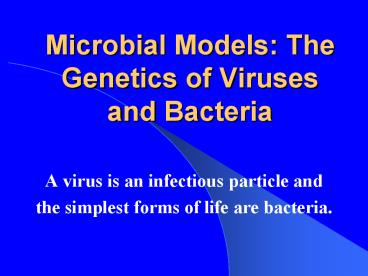Microbial Models: The Genetics of Viruses and Bacteria - PowerPoint PPT Presentation
1 / 23
Title:
Microbial Models: The Genetics of Viruses and Bacteria
Description:
conjugation. Detecting genetic recombination in bacteria. Transformation ... Conjugation= The direct transfer of genes between two cells that are temporarily ... – PowerPoint PPT presentation
Number of Views:81
Avg rating:3.0/5.0
Title: Microbial Models: The Genetics of Viruses and Bacteria
1
Microbial Models The Genetics of Viruses and
Bacteria
- A virus is an infectious particle and
- the simplest forms of life are bacteria.
2
Outline
- Outline
- 1. Key Concepts
- 2. The Structure of Viruses
- 3. Viral Reproduction
- 4. Infectious Agents Tinier Than Viruses
- 5. Key terms
- 6. Conclusions
- _____________________________________
- 7. Genetic recombination of Bacteria
- 8. Key Terms
- 9. Conclusions
3
Genetic recombination of Bacteria
- The short generation span of bacteria facilitates
their evolutionary adaptation to changing
environment - Circular DNA, Plasmid, one replication origin,
binary fission (produce clones), mutations - 2. Three natural processes of genetic
recombination in bacteria - a. Transformation
- b. Transduction
- c. Conjugation and plasmids
4
How Small Are Bacteria?
Magnified 14,000 times
Bacillus cells on the tip of a pin
5
Where is the bacterium?
6
Replication of the bacterial chromosome
7
E. Coli Dividing
8
Bacteria are very adaptable
- The major component of the bacterial genome is
one double-stranded, circular DNA molecule. - For E. coli, 100 times more DNA than in a typical
virus and 1,000 times less than in a typical
eukaryote cell. - In addition, many bacteria have plasmids, much
smaller circles of DNA. - Each plasmid has only a small number of genes,
from just a few to several dozen.
9
Bacteria are very adaptable
- Bacteria proliferate very rapidly in a favorable
natural or laboratory environment. - In the human colon, E. coli reproduces about 2 x
1010 bacteria lost each day in feces. - Through binary fission, most of the bacteria in a
colony are genetically identical to the parent
cell. - However, the spontaneous mutation rate of E.
coliis 1 x 10-7 mutations per gene per cell
division. - This will produce about 2,000 bacteria in the
human colon that have a mutation in that gene per
day.
10
Genetic recombination produces new bacterial
strains
- In addition to mutations, genetic recombination
generates diversity within bacterial populations. - Here, recombination is defined as the combining
of DNA from two individuals into a single genome. - Recombination occurs through three processes
transformation transduction
conjugation
11
Detecting genetic recombination in bacteria
12
Transformation
- Transformation Process of genetic transfer
during which a bacterial cell assimilates foreign
DNA from the surroundings - Take up naked DNA from the surroundings
- Assimilate foreign DNA
- Progeny will carry a new combination of genes
- E. coli can be artificially induced to take up
foreign DNA by incubating - This technique is used by Biotechnology industry
to introduce foreign genes into bacterial genomes
13
Transduction
- Transduction Gene transfer from one bacterium
to another by a bacteriophage - Generalized transduction occurs when random
pieces of host cell DNA are packaged within a
phage capsid during the lytic cycle of a phage - This process can transfer almost any host gene
- When the phage infects a new cell, the donor cell
DNA can recombine with the recipient cell DNA - Specialized transduction (restricted
transduction) - Transduced bacterial genes are restricted to
specific genes adjacent to the prophage insertion
site
14
Transductions
15
Conjugation and plasmids
- Conjugation The direct transfer of genes between
two cells that are temporarily jointed - Plasmid A small, circular, double-stranded,
self-replicating molecule ring of DNA in some
bacteria - Transposon (Transposable Genetic Element) DNA
sequence that can move from one chromosomal site
to another
16
Bacterial mating
17
Plasmids
18
Conjugation and recombination in E. coli
19
Conjugation and recombination in E. coli
20
Insertion sequences, the simplest transposons
21
Insertion of a transposon and creation of direct
repeats
22
Key Terms
Transformation Transduction Conjugation Plasmid Tr
ansposon Generalized transduction Specialized
transduction
23
In Conclusion
- 1. When bacteria divide, they form clones of
identical cells. - 2. A bacterium can transfer its genes to another
bacterium by transformation, transduction, or
conjugation. - 3. Plasmids are small bacterial DNA that are
independent of the main chromosome. - 4. Transposons are movable stretches of DNA that
can jump from one place to another.































